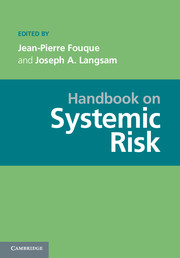Book contents
- Frontmatter
- Contents
- Contributors
- Introduction
- PART I DATA: THE PREREQUISITE FOR MANAGING SYSTEMIC RISK
- PART II STATISTICS AND SYSTEMIC RISK
- 6 Statistical Assessments of Systemic Risk Measures
- 7 Regime Switching Models and Risk Measurement Tools
- PART III MEASURING AND REGULATING SYSTEMIC RISK
- PART IV NETWORKS
- PART V SYSTEMIC RISK ANDMATHEMATICAL FINANCE
- PART VI COUNTERPARTY RISK AND SYSTEMIC RISK
- PART VII ALGORITHMIC TRADING
- PART VIII BEHAVIORAL FINANCE: THE PSYCHOLOGICAL DIMENSION OF SYSTEMIC RISK
- PART IX REGULATION
- PART X COMPUTATIONAL ISSUES AND REQUIREMENTS
- PART XI ACCOUNTING ISSUES
- References
7 - Regime Switching Models and Risk Measurement Tools
from PART II - STATISTICS AND SYSTEMIC RISK
Published online by Cambridge University Press: 05 June 2013
- Frontmatter
- Contents
- Contributors
- Introduction
- PART I DATA: THE PREREQUISITE FOR MANAGING SYSTEMIC RISK
- PART II STATISTICS AND SYSTEMIC RISK
- 6 Statistical Assessments of Systemic Risk Measures
- 7 Regime Switching Models and Risk Measurement Tools
- PART III MEASURING AND REGULATING SYSTEMIC RISK
- PART IV NETWORKS
- PART V SYSTEMIC RISK ANDMATHEMATICAL FINANCE
- PART VI COUNTERPARTY RISK AND SYSTEMIC RISK
- PART VII ALGORITHMIC TRADING
- PART VIII BEHAVIORAL FINANCE: THE PSYCHOLOGICAL DIMENSION OF SYSTEMIC RISK
- PART IX REGULATION
- PART X COMPUTATIONAL ISSUES AND REQUIREMENTS
- PART XI ACCOUNTING ISSUES
- References
Summary
Abstract Structural changes in the financial system, resulting in broader economic crisis, have the common theme of the creation of new money equivalents that have a sudden change in value and spark contagion in the broader credit markets. Approaches to modeling the financial system, with a sufficient level of precision to be able to predict or anticipate the collapse of key assets (e.g. money equivalents) has been hampered by a lack of data about the markets and participants.
Given the type of market data that is readily available, we consider a variety of time-series models which could be used to identify and potentially anticipate a structural change in the financial system. There are two key characteristics of asset prices, which are related to market stress: the level of volatility and the amount of correlation. Typically, volatility is modeled using an auto-regressive structure and if the parameters of this structure (e.g. the average level of volatility) are allowed to be driven by a marked Poisson process (e.g. a hidden Markov chain), then we have a tool for identifying regime shifts or structural changes in financial markets. While correlation models can be more complicated, because of the number of parameters, the same type of underlying dynamic structure of a marked Poisson process can be used to identify changes in a correlation structure.
- Type
- Chapter
- Information
- Handbook on Systemic Risk , pp. 180 - 190Publisher: Cambridge University PressPrint publication year: 2013
References
- 1
- Cited by



